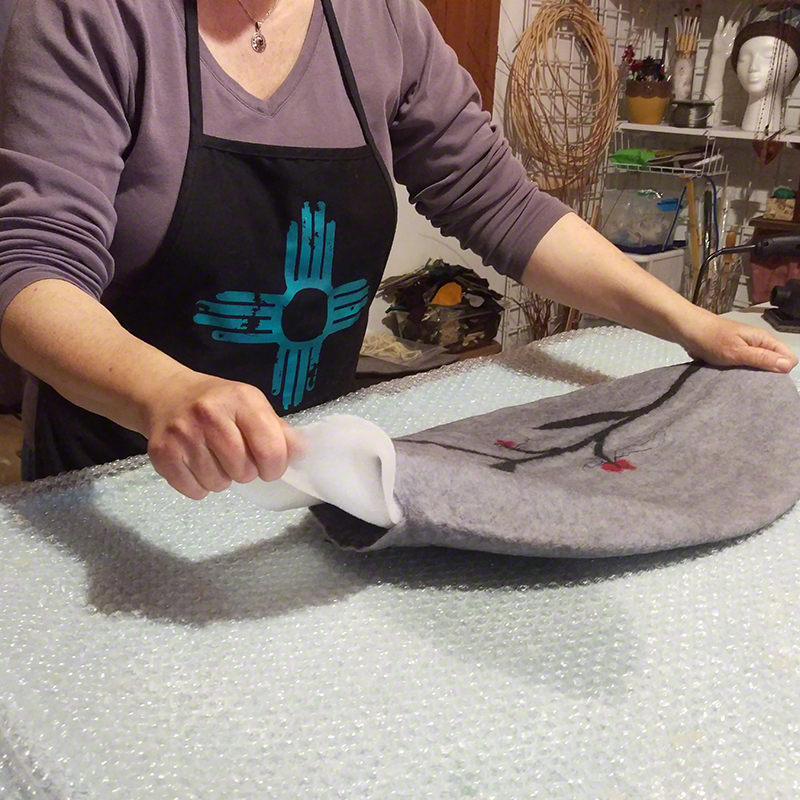Why Feltmaking?
My love of making felt was born out of a need for less structure and more fun in my life. In 2013, I began feeling stuck in my photographic work and thought maybe a hobby would get me 'un-stuck'. Indeed it worked, but unbeknownst to me, that hobby was going to turn into a full-time fiber art business...
I'd seen handmade felt at a few shows, and found it fascinating, but I couldn’t really wrap my head around how it was made. So, I bought some books, did some research, and began my journey into feltmaking.
I've spent the last several years devoted to learning and experimenting with different types of feltmaking, trying to find what resonated with me… what lit me up inside. I wanted to disappear into the zone that happens between the maker and what's being made. That complete connection… because to me, there’s no better place in the world.
Over the years, I’ve been privileged to learn techniques from a variety of accomplished fiber artists, such as Diane Christian, Sharon Costello, Marjolein Dallinga, Pam de Groot, Diana Nagorna, Lise Poulsen, and Maggy Pavlou.
I’ve used what I’ve learned, combined and tweaked those techniques, and integrated them into my own way of feltmaking.
Feltmaking
Felt is the oldest known textile, and there are various stories as to how man figured out how to make it. There's also much controversy over when exactly that first happened. Felt artifacts dating from as early as 600 BCE do exist, though some claim that feltmaking goes as far back as 8000 BCE. Regardless of when, none seem to dispute that the art of making felt predates spinning and weaving. There is absolutely no doubt that feltmaking has been around for thousands of years, and though I use a few modern tools, my methods are almost identical to those used in early times.
There are different ways to make felt. One is needle felting, also known as dry felting, which is a newer method that came about in the 1980's. This is how I first learned to felt, but now my preferred method is wet felting, as it was done in those early days.
I wet felt using sheep's wool, rainwater, and olive oil soap. The reason I use rainwater is not only for environmental reasons, (water conservation is part of life in the southwest) but the pH is perfect for felting, and I find the wool responds beautifully. (If you're a felter, you should try it!)
This felt is very soft to the touch, but can be made firm enough to hold a shape when required. I use a variety of wool from different breeds of sheep to accomplish this.
By laying and overlapping the wool fibers, adding soap and water, and pressing, agitating, tossing and rolling the wool, I am able to create the felt fabric. It absolutely seems like magic during the process, but the truth is that sheep hair has tiny microscopic scales that tangle and lock together during the felting and fulling process. The more I agitate them, the more they tangle, tighter and tighter together, shrinking along the way, and voilà… they've bonded together and turn into a very strong fabric that cannot be torn, or even fray.
The short video to the right shows traditional feltmaking. I thought I'd share it here, just to give you an idea of what I'm talking about...at least, until I can make a video of my own. :-D
I also couldn't resist sharing this video from Diana Nagorna, a feltmaker from Ukraine. I’m a great admirer of her work and thought this video was an excellent example of how I make my vessels, working around a resist. The resist material keeps both sides of the wool from felting together, keeping it hollow in between. The technique also allows one to make something in a single piece, without needing to sew.
If you watch the video up to about 9:00 minutes, this is pretty close to how I work. Our techniques differ in that I don’t use a sander to vibrate the wool, but prefer to do it by hand. But, if I was working on a large piece, like she is, I probably would use a sander to save time. (She must start much larger than her finished dress, as there’s a 30-50% shrinkage rate due to the tangling of the wool.)
Also, Ms. Nagorna is using a technique in this video called Nuno Felting, which is laminating fabric to the wool. This technique was created in the 1980's as a way to make lightweight garments with wool, that were still strong and durable. You’ll see her laying silk over the dress after she’s finished laying out her wool design. I use this technique with wearables, and on occasion with my sculptural pieces.
Affiliations
International Feltmakers Association (Regional Representative USA, 2019-2020)
Pojoaque River Art Tour (Treasurer 2012, Webmaster 2010-2019)

